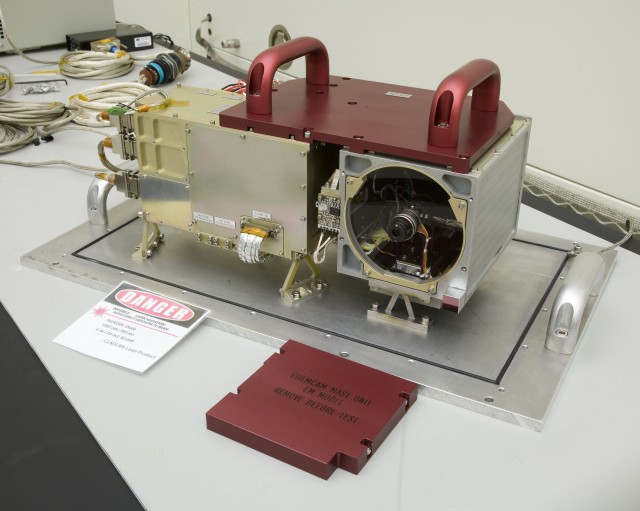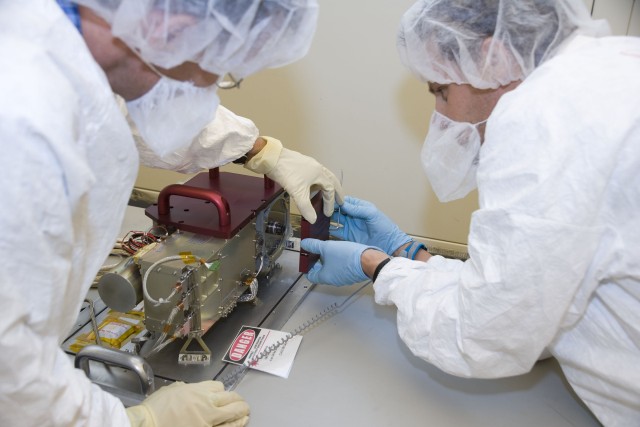Mars mission Job One: Get there. Job Two: Find rocks and zap them with your laser tool. Now learn the nature of the debris by spectrographically analyzing the ensuing dust and fragments. It’s every kid’s dream, vaporizing pebbles on other planets, and thanks to a team at Los Alamos National Laboratory, it’s going to happen.
When the JPL-NASA Mars Science Laboratory rover launches in 2009, it will carry this combination laser-telescope unit and enable the gadget-packed rover to know a great deal about rocks in its general vicinity. The ChemCam package includes a mast unit, projecting above the rover with a laser and telescope, and a body unit, the brains of the beast, with three spectrographs and the instrument controls.
The engineering model of ChemCam’s mast unit, fresh from Thales Laser and Centre d’Etude Spatiale des Rayonnements (CESR) in France, is undergoing rigorous testing at Los Alamos. A team of six French experts is checking out the mast unit this week and making sure that it is properly connected with the rest of the instrument, built at Los Alamos. This fall the entire instrument will be shipped to the Jet Propulsion Laboratory, where more tests will take place and additional equipment will be added.
In addition, see http://mars.jpl.nasa.gov/msl/mission/sc_instru_chemcam.html and http://mars.jpl.nasa.gov/msl/ online.
“We’re pioneering a new technique for exploring Mars. It’s really exciting to see the whole thing come together,” said Roger Wiens, project lead and a Los Alamos scientist.
The ChemCam laser emits very short pulses of 7 nanoseconds, through a small telescope that focuses the beam to a spot where the power density exceeds 10 megawatts per square millimeter, producing a plasma of vaporized material from the target rock. The unit operates on targets at distances between 4 and 30 feet. The unit also contains a camera to take extreme close-up pictures of the targets to show geologic context for each sample. The telescope and electronics were built by CESR, a research institute in Toulouse, France. The mast unit was funded by CNES, the French Space Agency. The full ChemCam flight model will be delivered to JPL in Spring of 2008.
Scheduled to launch in the fall of 2009, Mars Science Laboratory is part of NASA’s Mars Exploration Program, a long-term effort of robotic exploration of the red planet. Mars Science Laboratory is a rover that will assess whether Mars ever was, or is still today, an environment able to support microbial life. In other words, its mission is to determine the planet’s habitability.
Los Alamos National Laboratory, a multidisciplinary research institution engaged in strategic science on behalf of national security, is operated by Los Alamos National Security, LLC, a team composed of Bechtel National, the University of California, The Babcock & Wilcox Company, and Washington Group International for the Department of Energy's National Nuclear Security Administration.
Los Alamos enhances national security by ensuring the safety and reliability of the U.S. nuclear stockpile, developing technologies to reduce threats from weapons of mass destruction, and solving problems related to energy, environment, infrastructure, health, and global security concerns.


